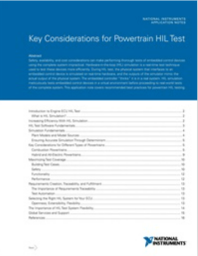Key Considerations for Powertrain HIL Test
Safety, availability, and cost considerations can make performing thorough tests of embedded control devices
using the complete system impractical.
Hardware-in-the-loop (HIL) simulation is a real-time test technique used to test these devices more efficiently.
During HIL test, the physical system that interfaces to an embedded control device is simulated on real-time hardware, and the outputs of the simulator mimic the actual output of the physical system. The embedded controller “thinks” it is in a real system.
HIL simulation meticulously tests embedded control devices in a virtual environment before proceeding to real-world tests of the complete system.
This whitepaper covers recommended best practices for powertrain HIL testing.
Read More
By submitting this form you agree to NI contacting you with marketing-related emails or by telephone. You may unsubscribe at any time. NI web sites and communications are subject to their Privacy Notice.
By requesting this resource you agree to our terms of use. All data is protected by our Privacy Notice. If you have any further questions please email dataprotection@techpublishhub.com


More resources from NI

Fundamentals of Building a Test System
Most organizations do not consider production test a top priority, but it is a necessity to prevent major quality issues in the products that repre...

The Ultimate Guide to Managing Obsolescence in Aerospace and Defense
Test engineers spend as much as 50 percent of their time (or even more in some cases) actively dealing with obsolescence in their test program sets...

Practical Guide to Maximizing DC Measurement Performance
This guide will begin by reviewing instrument fundamentals, learning how to use SMUs, and examining the features that can help you set up your inst...
